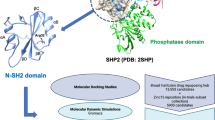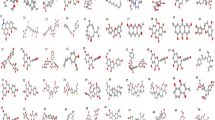Abstract
Matrix metalloproteinases (MMPs) are the major proteolytic enzymes which assist in regulating the metastatic process by degrading the extracellular matrix proteins. In this study, we have investigated the anti-metastatic potential of major bioactive compounds in the medicinal plant Indigofera aspalathoides targeting matrix metalloproteinases (MMP2 & MMP9) and it’s in silico pharmacokinetic profiles using computational studies. Indigofera aspalathoides (Sivanar vembu in Tamil) is a renowned medicinal herb in traditional Indian medicine which contains indigocarpan, mucronulatol, indigocarpan diacetate, erythroxydiol X and erythroxydiol Y as the major constituents. The 3-dimensional structure of MMP2 and MMP9 was designed by using I-tasser and Modeller and it was validated by PROCHECK. The structures of mucronulatol and indigocarpan have been retrieved from PubChem and indigocarpan diacetate, erythroxydiol X & Y were drawn by using Chemdraw Ultra 6.0. Batimastat was used as a positive control. Molecular docking was performed by using AutoDock 4.2 tools and AutoDock vina, an open-source program which signifies an effective interaction between the phytoligands and MMP2 & MMP9. From the results, AutoDock 4.2 have showed that indigocarpan possesses strong binding energy (ΔG) of − 7.68 kcal/mol towards MMP2 and − 6.35 kcal/mol towards MMP9, whereas batimastat showed binding energy (ΔG) of − 6.34 kcal/mol for MMP2 and − 5.66 kcal/mol for MMP9, meanwhile the results from AutoDock vina indicates that indigocarpan possesses strong binding energy (ΔG) of − 8.0 kcal/mol towards MMP2 and − 8.2 kcal/mol towards MMP9, whereas batimastat showed binding energy (ΔG) of − 7.2 kcal/mol for MMP2 and − 7.6 kcal/mol for MMP9. Also, the ADME and toxicity results suggest that the indigocarpan compound possesses a druggable pharmacokinetic potentiality and does not have carcinogenicity and Ames mutagenesis compared with other phytoligands. Hence, it is evident from our results that both AutoDock platforms strongly revealed that the phytoligand, indigocarpan possesses strong inhibitory activity against MMP2 and MMP9 to control cancer metastasis.








Similar content being viewed by others
References
Ajeet KA, Mishra AK (2018) Design, molecular docking, synthesis, characterization, biological activity evaluation (against MES model), in-silico biological activity spectrum (PASS analysis), toxicological and predicted oral rat LD50 studies of novel sulphonamide derivatives. Front Biol 13:425–451. https://doi.org/10.1007/s11515-018-1512-4
Bhagavan NB, Arunachalam S, Dhasarathan P, Kannan ND (2013) Evaluation of anti inflammatory activity of Indigofera aspalathoides Vahl in Swiss albino mice. J Pharm Res 6:350–354. https://doi.org/10.1016/j.jopr.2013.02.018
Boopathi S, Huy PDQ, Gonzalez W, Theodorakis PE, Li MS (2020) Zinc binding promotes greater hydrophobicity in Alzheimer’s Aβ42 peptide than copper binding: molecular dynamics and solvation thermodynamics studies. Proteins 88:1285–1302. https://doi.org/10.1002/prot.25901
Cathcart J, Pulkoski-Gross A, Cao J (2015) Targeting matrix metalloproteinases in cancer: bringing new life to old ideas. Genes Diseases 2:26–34. https://doi.org/10.1016/j.gendis.2014.12.002
Daina A, Michielin O, Zoete V (2014) iLOGP: a simple, robust, and efficient description of n-octanol/water partition coefficient for drug design using the GB/SA approach. J Chem Inf Model 54:3284–3301. https://doi.org/10.1021/ci500467k
Daina A, Michielin O, Zoete V (2017) SwissADME: a free web tool to evaluate pharmacokinetics, drug-likeness and medicinal chemistry friendliness of small molecules. Sci Rep 7:42717. https://doi.org/10.1038/srep427171
Deryugina EI, Quigley JP (2006) Matrix metalloproteinases and tumor metastasis. Cancer Metastasis Rev 25:9–34. https://doi.org/10.1007/s10555-006-7886-9
Fares J, Fares MY, Khachfe HH, Salhab HA, Fares Y (2020) Molecular principles of metastasis: a hallmark of cancer revisited. Signal Transduct Target Ther 5:28. https://doi.org/10.1038/s41392-020-0134-x
Geourjon C, Deleage G (1995) SOPMA: significant improvements in protein secondary structure prediction by consensus prediction from multiple alignments. CABIOS 11:681–684. https://doi.org/10.1093/bioinformatics/11.6.681
Guilloux VL, Schmidtke P, Tuffery P (2009) Fpocket: An open source platform for ligand pocket detection. BMC Bioinform 10:168. https://doi.org/10.1186/1471-2105-10-168
Han Y, Zhang J, Hu CQ, Zhang X, Ma B, Zhang P (2019) In silico ADME and toxicity prediction of ceftazidime and its impurities. Front Pharmacol 10:1–12. https://doi.org/10.3389/fphar.2019.00434
Heo L, Park H, Seok C (2013) GalaxyRefine: protein structure refinement driven by side-chain repacking. Nucleic Acids Res 41:W384–W388. https://doi.org/10.1093/nar/gkt458
Jabłonska-Trypuc A, Matejczyk M, Rosochacki S (2016) Matrix metalloproteinases (MMPs), the main extracellular matrix (ECM) enzymes in collagen degradation, as a target for anticancer drugs. J Enzyme Inhib Med Chem 31:177–183. https://doi.org/10.3109/14756366.2016.1161620
Kaushik P, Saini DK (2019) Sequence analysis and homology modelling of SmHQT protein, a key player in chlorogenic acid pathway of eggplant. biorXiv. https://doi.org/10.1101/599282
Kessenbrock K, Plaks V, Werb Z (2010) Matrix metalloproteinases: regulators of the tumor microenvironment. Cell 141:52–67. https://doi.org/10.1016/j.cell.2010.03.015
Kumar G, Patnaik R (2018) Inhibition of Gelatinases (MMP-2 and MMP-9) by Withania somnifera phytochemicals confers neuroprotection in stroke: an in silico analysis. Interdiscip Sci Comput Life Sci 10:722–733. https://doi.org/10.1007/s12539-017-0231-x
Kunz P, Sahr H, Lehner B, Fischer C, Seebach E, Fellenberg J (2016) Elevated ratio of MMP2/MMP9 activity is associated with poor response to chemotherapy in osteosarcoma. BMC Cancer 16:223. https://doi.org/10.1186/s12885-016-2266-5
Laskowski RA, MacArthur MW, Moss DS, Thornton JM (1993) PROCHECK: a program to check the stereochemical quality of protein structures. J Appl Cryst 26:283–291. https://doi.org/10.1107/S0021889892009944
Leber MF, Efferth T (2009) Molecular principles of cancer invasion and metastasis (Review). Int J Oncol 34:881–895. https://doi.org/10.3892/ijo_00000214
Lee GR, Heo L, Seok C (2016) Effective protein model structure refinement by loop modeling and overall relaxation. Proteins 84:293–301. https://doi.org/10.1002/prot.24858
Loffek S, Schilling O, Franzke CW (2011) Biological role of matrix metalloproteinases: a critical balance. Eur Respir J 38:191–208. https://doi.org/10.1183/09031936.00146510
Marti-Renom MA, Stuart AC, Fiser A, Sanchez R, Melo F, Sali A (2000) Comparative protein structure modeling of genes and genomes. Annu Rev Biophys Biomol Struct 29:291–325. https://doi.org/10.1146/annurev.biophys.29.1.291
Messaoudi A, Belguith H, Hamida JB (2013) Homology modeling and virtual screening approaches to identify potent inhibitors of VEB-1 β-lactamase. Theor Biol Med Model 10:1–10. https://doi.org/10.1186/1742-4682-10-22
Moreira RA, Guzman HV, Boopathi S, Baker JL, Poma AB (2020) Characterization of structural and energetic differences between conformations of the SARS-CoV-2 Spike Protein. Materials 13(23):1–14. https://doi.org/10.3390/ma13235362
Morris GM, Huey R, Lindstrom W, Sanner MF, Belew RK, Goodsell DS, Olson AJ (2009) AutoDock4 and AutoDockTools4: automated docking with selective receptor flexibility. J Comput Chem 30:2785–2791. https://doi.org/10.1002/jcc.21256
Paramashivam SK, Elayaperumal K, Natarajan BB, Ramamoorthy MD, Balasubramanian S, Dhiraviam KN (2015) In silico pharmacokinetic and molecular docking studies of small molecules derived from Indigofera aspalathoides Vahl targeting receptor tyrosine kinases. Bioinformation 11:73–84. https://doi.org/10.6026/97320630011073
Parhi P, Suklabaidya S, Sahoo SK (2017) Enhanced anti-metastatic and antitumorigenic efficacy of Berbamine loaded lipid nanoparticles in vivo. Sci Rep 7:5806. https://doi.org/10.1038/s41598-017-05296-y
Quintero-Fabián S, Arreola R, Becerril-Villanueva E, Torres-Romero JC, Arana-Argáez V, Lara-Riegos J, Ramírez-Camacho MA, Alvarez-Sánchez ME (2019) Role of matrix metalloproteinases in angiogenesis and cancer. Front Oncol 9:1370. https://doi.org/10.3389/fonc.2019.01370
Rajkapoor B, Jayakar B, Murugesh N (2004) Antitumor activity of Indigofera aspalathoides on Ehrlich ascites carcinoma in mice. Indian J Pharmacol 36:38–40
Rathee D, Lather V, Grewal AS, Dureja H (2018) Targeting matrix metalloproteinases with novel diazepine substituted cinnamic acid derivatives: design, synthesis, in vitro and in silico studies. Chem Cent J 12:41. https://doi.org/10.1186/s13065-018-0411-8
Roy K, Roy PP (2009) Comparative chemometric modeling of cytochrome 3A4 inhibitory activity of structurally diverse compounds using stepwise MLR, FA-MLR, PLS, GFA, G/PLS and ANN techniques. Eur J Med Chem 44:2913–2922. https://doi.org/10.1016/j.ejmech.2008.12.004
Saraswathy A, Mathuram V, Allirani T (2013) Chemical constituents of Indigofera aspalathoides Vahl. Ex DC J Pharmacogn Phytochem 2:74–80
Selvam C, Jachak SM, Oli RG, Ramasamy T, Chakrabortib AK, Bhutani KK (2004) A new cyclooxygenase (COX) inhibitory pterocarpan from Indigofera aspalathoides: structure elucidation and determination of binding orientations in the active sites of the enzyme by molecular docking. Tetrahedron Lett 45:4311–4314. https://doi.org/10.1016/j.tetlet.2004.04.010
Selvaraj G, Kaliamurthi S, Thiruganasambandam R (2016) Molecular docking studies of rutin on 7matrix metalloproteinase. Insights in Biomedicine 1:4
Seyfried TN, Huysentruyt LC (2013) On the origin of cancer metastasis. Crit Rev Oncog 18:43–73
Shin W, Lee GR, Heo L, Lee H, Seok C (2014) Prediction of protein structure and interaction by GALAXY protein modeling programs. Bio Design 2:1–11
Sivagnanam SK, Rao MRK, Balasubramanian MP (2012) Chemotherapeutic efficacy of Indigofera aspalathoides on 20-methylcholanthrene-Induced Fibrosarcoma in Rats. ISRN Pharmacology 20:1–7. https://doi.org/10.5402/2012/134356
Swarnalatha S, Umamaheswari A, Puratchikody A (2015) Immunomodulatory activity of kaempferol 5-O-b-Dglucopyranoside from Indigofera aspalathoides Vahl ex DC. (Papilionaceae). Med Chem Res 24:2889–2897. https://doi.org/10.1007/s00044-015-1341-9
Trott O, Olson AJ (2010) AutoDock Vina: improving the speed and accuracy of docking with a new scoring function, efficient optimization and multithreading. J Comput Chem 31(2):455–461. https://doi.org/10.1002/jcc.21334
Ujan R, Saeed A, Channar PA, Larik FA, Abbas Q, Alajmi MF, El-Seedi HR, Rind MA, Hassan M, Raza H, Seo S (2019) Drug-1,3,4-thiadiazole conjugates as novel mixed-Type inhibitors of acetylcholinesterase: synthesis, molecular docking, pharmacokinetics, and ADMET evaluation. Molecules 24:1–14. https://doi.org/10.3390/molecules24050860
Webb B, Sali A (2016) Comparative protein structure modeling using MODELLER. Curr Protoc Bioinformatics. 54: 5.6.1–5.6.37. http://doi.org/https://doi.org/10.1002/cpbi.3
Winer A, Adams S, Mignatti P (2018) Matrix metalloproteinase inhibitors in cancer therapy: turning past failures into future successes. Mol Cancer Ther 17:1147–1155. https://doi.org/10.1158/1535-7163.MCT-17-0646
Woo JK, Jung HJ, Park JY, Kang JH, Lee BI, Shin DY, Nho CW, Cho SY, Seong JK, Oh SH (2017) Daurinol blocks breast and lung cancer metastasis and development by inhibition of focal adhesion kinase (FAK). Oncotarget 8:57058–57071. https://doi.org/10.18632/oncotarget.18983
Yang J, Zhang Y (2015) I-TASSER server: new development for protein structure and function predictions. Nucleic Acids Res 43:W174–W181. https://doi.org/10.1093/nar/gkv342
Yang J, Roy A, Zhang Y (2013a) Protein–ligand binding site recognition using complementary binding-specific substructure comparison and sequence profile alignment. Bioinformatics 29:2588–2595. https://doi.org/10.1093/bioinformatics/btt447
Yang J, Roy A, Zhang Y (2013b) BioLiP: a semi-manually curated database for biologically relevant ligand–protein interactions. Nucleic Acids Res 41:D1096–D1103. https://doi.org/10.1093/nar/gks966
Yang J, Yan R, Roy A, Xu D, Poisson J, Zhang Y (2015) The I-TASSER Suite: protein structure and function prediction. Nat Methods 12:7–8. https://doi.org/10.1038/nmeth.3213
Zhou R, Xu L, Ye M, Liao M, Du H, Chen H (2014) Formononetin inhibits migration and invasion of MDA-MB-231 and 4T1 breast cancer cells by suppressing MMP-2 and MMP-9 Through PI3K/AKT Signaling Pathways. Horm Metab Res 46:753–760. https://doi.org/10.1055/s-0034-1376977
Acknowledgements
SathishKumar Paramashivam thanks UGC, NewDelhi, for providing SRF fellowship under UGC-BSR Meritorious Research Fellowship Scheme (F.No. 25-1/2014-15(BSR)/7-120/2007(BSR) dated 15.10.2015). The authors thank Dr.Subramanian Boopathi, PostDoctoral Scientist from School of Engineering in Bioinformatics, University of Talca, Chile for his help in our work.
Author information
Authors and Affiliations
Contributions
NDK conceived and designed the research. NDK and PS conducted the experiments and analyzed the data. PS wrote the manuscript. Both authors read and approved the manuscript.
Corresponding author
Ethics declarations
Conflict of interest
The authors declare that they have no conflict of interest in the publication.
Supplementary Information
Below is the link to the electronic supplementary material.
Rights and permissions
About this article
Cite this article
Paramashivam, S., Dhiraviam, K.N. Computational insights into the identification of a potent matrix metalloproteinase inhibitor from Indigofera aspalathoides to control cancer metastasis. 3 Biotech 11, 206 (2021). https://doi.org/10.1007/s13205-021-02731-w
Received:
Accepted:
Published:
DOI: https://doi.org/10.1007/s13205-021-02731-w




